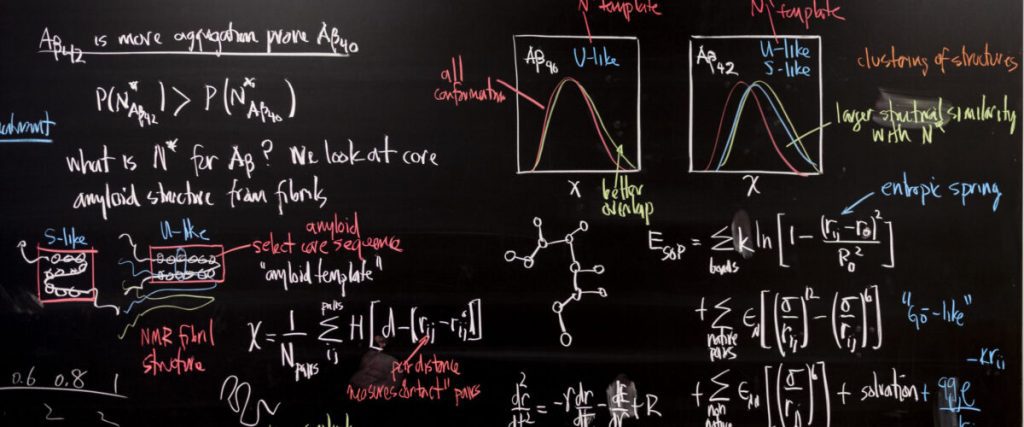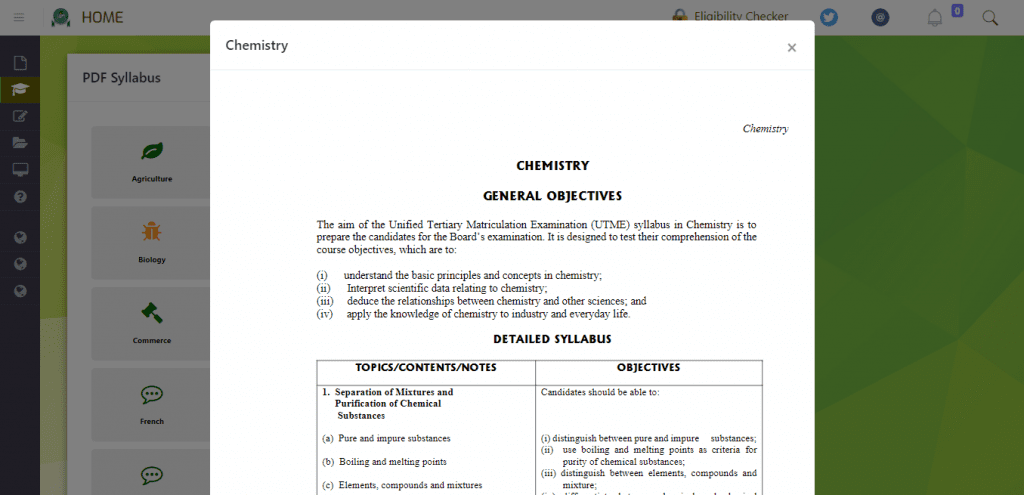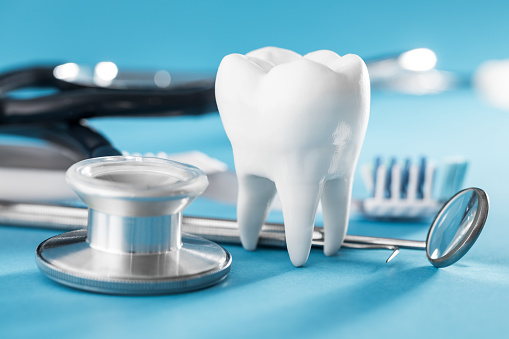JAMB Chemistry Syllabus 2024/2025: Is JAMB Syllabus for Chemistry out for this year’s JAMB?, When will JAMB Chemistry syllabus be out?, JAMB Chemistry Syllabus, What topics do JAMB set questions from Chemistry the most?, what is the most repeated topic in JAMB Chemistry?
Welcome SAVANT! to another exciting episode of my “JAMB Doctor Series“, in this episode I will provide you with the official topics recognize by JAMB, which JAMB expect you are a guru in before entering the hall to sit for your JAMB Chemistry Exam. STAY TUNED!

Have you ever wondered where you can find the topics for Chemistry JAMB normally asks or the most repeated topics or question in JAMB Chemistry? then you are a step away from finding your answer.
The short answer to the above question is “JAMB Syllabus”, in fact, JAMB Syllabus is the only expo you will be getting as you prepare for 2024/2025 UTME Exams, this syllabus contains area of concentrations and topics your questions will be asked from.
Read Also: WAEC Marking Scheme For All subjects: Grading System
ARE YOU ON TELEGRAM? Subscribe To My Telegram Channel For Frequent Updates & Guide by clicking the "SUBSCRIBE NOW" button below.
Any smart students would cherish this piece (Syllabus) and make effective use of it, the fact that you are searching for this now, simply means you are in the right direction. you should see my top notch guide on How To Pass JAMB 2023/2024 With High Score (300+).
For the sake of students who do not fully understand what JAMB syllabus is, I will give a brief explanation about this and then provide you with the relevant topics and area of concentration as provided in JAMB Chemistry Syllabus
I will also make the pdf available for download at the end of this write up… Enjoy!
What Is JAMB Chemistry Syllabus?

JAMB Syllabus for Chemistry is a collection of topics JAMB expects students to be well grounded in before they sit for their Chemistry exam. If Chemistry is one of the subjects you will sit for in JAMB, then you need this Chemistry syllabus.
This syllabus were actually compiled by JAMB, so it is something you can rely on.
The aim of the Unified Tertiary Examination Board Syllabus in Chemistry is to guide candidates in their preparation for the Board’s exam.
Advantages of Using JAMB Chemistry Syllabus To Prepare?
Of course using JAMB syllabus to prepare for Chemistry in JAMB has its perks, some of these advantages includes…
- Expose you to topics you never taught were important
- You begin to see how JAMB thinks, and also expose you to what you should expects in different topics
- On the syllabus is also contained recommended textbooks, using JAMB recommended textbooks is key
With these I hope you will grab the opportunity of making good use of JAMB Chemistry Syllabus I will be providing you with shortly…
Read Also: JAMB Profile 2024/2025: How To Create & Access It (All To Know)
JAMB Chemistry Syllabus

JAMB Chemistry syllabus is designed to evaluate your ability to:
- Understand the basic principles and concepts in chemistry;
- Interpret scientific data relating to chemistry;
- Deduce the relationships between chemistry and other sciences;
- Apply the knowledge of chemistry to industry and everyday life.
Download your copy of the syllabus here👇
Below is a detailed list of JAMB Chemistry syllabus/Content
1. Separation of mixtures and purification of chemical substances
TOPICS:
- Pure and impure substances
- Boiling and melting points.
- Elements, compounds and mixtures
- Chemical and physical changes.
- Separation processes: evaporation, simple and fractional distillation, sublimation, filtration, crystallization, paper and column chromatography, simple and fractional crystallization, magnetization, decantation.
Study Objectives:
Candidates should be able to:
- distinguish between pure and impure substances;
- use boiling and melting points as criteria for purity of chemical substances;
- distinguish between elements, compounds and mixture;
- differentiate between chemical and physical changes;
- identify the properties of the components of a mixture;
- specify the principle involved in each separation method.
- apply the basic principle of separation processes in everyday life.
2. Chemical combination
TOPICS:
- Stoichiometry
- laws of definite and multiple proportions
- law of conservation of matter
- Gay Lussac’s law of combining volumes
- Avogadro’s law; chemical symbols, formulae, equations and their uses, relative atomic mass based on 1212C=12, the mole concept and Avogadro’s number.
Study Objectives:
Candidates should be able to:
- perform simple calculations involving formulae, equations/chemical composition and the mole concept;
- deduce the chemical laws from given expressions/statements/data;
- interpret graphical representations related to these laws;
- deduce the stoichiometry of chemical reactions.
3. Kinetic theory of matter and Gas Laws
TOPICS:
- An outline of the kinetic theory of matter;
- melting,
- vapourization
- boiling
- freezing
- condensation in terms of molecular motion and Brownian movement.
- The laws of Boyle, Charles, Graham and Dalton (law of partial pressure); combined gas law, molar volume and atomicity of gases.
- The ideal gas equation (PV = nRT).
- The relationship between vapour density of gases and the relative molecular mass.
Study Objectives:
Candidates should be able to:
- apply the theory to distinguish between solids, liquids and gases;
- deduce reasons for change of state;
- draw inferences based on molecular motion;
- deduce gas laws from given expressions/ statements;
- interpret graphical representations related to these laws;
- perform simple calculations based on these laws, equations and relationships
4. Atomic structure and bonding
TOPICS:
- The concept of atoms, molecules and ions, the works of Dalton, Millikan, Rutherford, Moseley, Thompson and Bohr.
- Atomic structure, electron configuration, atomic number, mass number and isotopes; specific examples should be drawn from elements of atomic number 1 to 20.
- Shapes of s and p orbitals.
- The periodic table and periodicity of elements, presentation of the periodic table with a view to recognizing families of elements e.g. alkali metals, halogens, the noble gases and transition metals. The variation of the following properties: ionization energy, ionic radii, electron affinity and electronegativity.
- Chemical bonding. Electrovalency and covalency, the electron configuration of elements and their tendency to attain the noble gas structure. Hydrogen bonding and metallic bonding as special types of electrovalency and covalency respectively; coordinate bond as a type of covalent bond as illustrated by complexes like [Fe(CN)66]3−3−, [Fe(CN)66]4−4−, [Cu(NH33)44]2+2+ and [Ag(NH33)22]++; van der Waals’ forces should be mentioned as a special type of bonding forces.
- Shapes of simple molecules: linear ((H22, O22, Cl22,HCl and CO22), non-linear (H22O) and tetrahedral; (CH44) and pyramidal (NH33).
- Nuclear Chemistry:
- Radioactivity – Types and properties of radiations
- Nuclear reactions. Simple equations, uses and applications of natural and artificial radioactivity.
5. Air
TOPICS:
- The natural gaseous constituents and their proportion in the air.- nitrogen, oxygen, water vapour, carbon (IV) oxide and the noble gases (argon and neon).
- Air as a mixture and some uses of the noble gas.
Study Objectives:
Candidates should be able to:
- deduce reason (s) for the existence of air as a mixture;
- identify the principle involved in the separation of air components;
- deduce reasons for the variation in the composition of air in the environment;
- specify the uses of some of the constituents of air.
6. Water
TOPICS:
- Water as a product of the combustion of hydrogen and its composition by volume.
- Water as a solvent, atmospheric gases dissolved in water and their biological significance.
- Hard and soft water: Temporary and permanent hardness and methods of softening hard water.
- Treatment of water for town supply.
- Water of crystallization, efflorescence, deliquescence and hygroscopy. Examples of the substances exhibiting these properties and their uses.
Study Objectives:
Candidates should be able to:
- identify the various uses of water;
- identity the effects of dissolved atmospheric gases in water;
- distinguish between the properties of hard and soft water;
- determine the causes of hardness;
- identify methods of removal of hardness;
- describe the processes involved in the treatment of water for town supply;
- distinguish between these phenomena;
- identify the various compounds that exhibit these phenomena.
7. Solubility
TOPICS:
- Unsaturated, saturated and supersaturated solutions. Solubility curves and simple deductions from them, (solubility defined in terms of mole per dm33) and simple calculations.
- Solvents for fats, oil and paints and the use of such solvents for the removal of stains.
- False solution (Suspensions and colloids): Properties and examples. Harmattan haze and water paints as examples of suspensions and fog, milk, aerosol spray, emulsion paints and rubber solution as examples of colloids.
Study Objectives:
Candidates should be able to:
- distinguish between the different types of solutions;
- interpret solubility curves;
- calculate the amount of solute that can dissolve in a given amount of solvent at a given temperature;
- deduce that solubility is temperature-dependent;
- relate nature of solvents to their uses;
- differentiate among true solution, suspension and colloids;
- compare the properties of a true solution and a ‘false’ solution.
- provide typical examples of suspensions and colloids.
8. Environmental Pollution
TOPICS:
- Sources and effects of pollutants.
- Air pollution: Examples of air pollutants such as H22S, CO, SO22, oxides of nitrogen, chlorofluorocarbons and dust.
- Water pollution Sewage and oil pollution should be known.
- Soil pollution: Oil spillage, Biodegradable and non-biodegradable pollutants.
Study Objectives:
Candidates should be able to:
- identify the different types of pollution and pollutants;
- specify different sources of pollutants
- classify pollutants as biodegradable and non-biodegradable;
- specify the effects of pollution on the environment;
- identify measures for control of environmental pollution.
9. Acids, bases and salts
TOPICS:
- General characteristics and properties of acids, bases and salts. Acids/base indicators, basicity of acids; normal, acidic, basic and double salts. An acid defined as a substance whose aqueous solution furnishes H33O++ions or as a proton donor. Ethanoic, citric and tartaric acids as examples of naturally occurring organic acids, alums as examples of double salts, preparation of salts by neutralization, precipitation and action of acids on metals. Oxides and trioxocarbonate (IV) salts
- Qualitative comparison of the conductances of molar solutions of strong and weak acids and bases, relationship between conductance and amount of ions present.
- pH and pOH scale; Simple calculations
- Acid/base titrations.
- Hydrolysis of salts: Principle Simple examples such as NH44Cl, AlCl33, Na22CO33 and CH33COONa
Study Objectives:
Candidates should be able to:
- distinguish between the properties of acids and bases;
- identify the different types of acids and bases;
- determine the basicity of acids;
- differentiate between acidity and alkalinity using acid/base indicators;
- identify the various methods of preparation of salts;
- classify different types of salts;
- relate degree of dissociation to strength of acids and bases;
- relate degree of dissociation to conductance;
- perform simple calculations on pH and pOH;
- identify the appropriate acid-base indicator;
- interpret graphical representation of titration curves;
- perform simple calculations based on the mole concept;
- balance equations for the hydrolysis of salts;
- deduce the properties (acidic, basic, neutral) of the resultant solution.
10. Oxidation and reduction
TOPICS:
- Oxidation in terms of the addition of oxygen or removal of hydrogen.
- Reduction as removal of oxygen or addition of hydrogen.
- Oxidation and reduction in terms of electron transfer.
- Use of oxidation numbers. Oxidation and reduction treated as change in oxidation number and use of oxidation numbers in balancing simple equations.
- IUPAC nomenclature of inorganic compounds using oxidation number.
- Tests for oxidizing and reducing agents.
11. Electrolysis
TOPICS:
- Electrolytes and non-electrolytes. Faraday’s laws of electrolysis.
- Electrolysis of dilute H22SO44, aqueous CuSO44, CuCl22 solution, dilute and concentrated NaCl solutions and fused NaCl
- Factors affecting discharge of ions at the electrodes.
- Uses of electrolysis: Purification of metals e.g. copper and production of elements and compounds (Al, Na, O22, Cl22 and NaOH).
- Electrochemical cells: Redox series (K, Ca, Na, Mg, Al, Zn, Fe, Sn, Pb, H, Cu, Hg, Ag, Au,) half-cell reactions and electrode potentials. (Simple calculations only).
- Corrosion as an electrolytic process, cathodic protection of metals, painting, electroplating and coating with grease or oil as ways of preventing iron from corrosion.
Study Objectives:
Candidates should be able to:
- distinguish between electrolytes and non-electrolytes;
- perform calculations based on faraday as a mole of electrons.
- identify suitable electrodes for different electrolytes.
- specify the chemical reactions at the electrodes;
- determine the products at the electrodes;
- identify the factors that affect the products of electrolysis;
- specify the different areas of application of electrolysis;
- identify the various electrochemical cells;
- calculate electrode potentials using half-cell reaction equations;
- determine the different areas of application of electrolytic processes;
- identify methods used in protecting metals.
12. Energy changes
TOPICS:
- Energy changes ∆H accompanying physical and chemical changes: dissolution of substances in/or reaction with water e.g. Na, NaOH, K, NH4Cl. Endothermic +∆H and exothermic -∆H reactions.
- Entropy as an order-disorder phenomenon: simple illustrations like mixing of gases and dissolution of salts.
- Spontaneity of reactions: ∆Goo = 0 as a criterion for equilibrium, ∆G greater or less than zero as a criterion for non-spontaneity or spontaneity respectively.
Study Objectives:
Candidates should be able to:
- determine the types of heat changes ∆H in physical and chemical processes;
- interpret graphical representations of heat changes;
- relate the physical state of a substance to the degree of orderliness;
- determine the conditions for spontaneity of a reaction ;
- relate∆Hoo , ∆Soo and ∆Goo as the driving forces for chemical reactions;
- solve simple problems based on the relationships ∆Goo = ∆Hoo – T∆Soo
13. Rates of Chemical Reaction
TOPICS:
- Elementary treatment of the following factors which can change the rate of a chemical reaction:
- Temperature e.g. the reaction between HCl and Na22S22O33 or Mg and HCl
- Concentration e.g. the reaction between HCl and Na22S22O33 HCl and marble and the iodine clock reaction, for gaseous systems, pressure may be used as concentration term.
- Surface area e.g. the reaction between marble and HCl with
- marble in
- powdered form
- lumps of the same mass.
- Catalyst e.g. the decomposition of H22O22 or KClO33 in the presence or absence of MnO22
- Reaction rate curves.
- Activation energy Qualitative treatment of Arrhenius’ law and the collision theory, effect of light on some reactions. e.g. halogenation of alkanes
14. Chemical equilibrium
TOPICS:
- Reversible reactions and factors governing the equilibrium position.
- Dynamic equilibrium.
- Le Chatelier’s principle and equilibrium constant.
- Simple examples to include action of steam on iron and N22O44 ⇌⇌ 2NO22. No calculation will be required.
Study Objectives:
Candidates should be able to:
- identify the factors that affects the position of equilibrium of a chemical reaction;
- predict the effects of each factor on the position of equilibrium;
- determine the effects of these factors on equilibrium constant.
15. Non-metals and their compounds
TOPICS:
- Hydrogen: commercial production from water gas and cracking of petroleum fractions, laboratory preparation, properties, uses and test for hydrogen.
- Halogens: Chlorine as a representative element of the halogen. Laboratory preparation, industrial preparation by electrolysis, properties and uses, e.g. water sterilization, bleaching, manufacture of HCl, plastics and insecticides. Hydrogen chloride and Hydrochloric acid: Preparation and properties. Chlorides and test for chlorides.
- Oxygen and Sulphur
- Oxygen: Laboratory preparation, properties and uses. Commercial production from liquid air. Oxides: Acidic,basic, amphoteric and neutral, trioxygen (ozone) as an allotrope and the importance of ozone in the atmosphere.
- Sulphur: Uses and allotropes: preparation of allotropes is not expected . Preparation, properties and uses of sulphur(IV) oxide, the reaction of SO22 with alkalis. Trioxosulphate (IV) acid and its salts, the effect of acids on salts of trioxosulphate(IV), Tetraoxosulphate(VI) acid: Commercial preparation (contact process only), properties as a dilute acid, an oxidizing and a dehydrating agent and uses. Test for SO2−442−. Hydrogen sulphide: Preparation and properties as a weak acid, reducing agent and precipitating agent. Test for S2−2−
- Nitrogen:
- Laboratory preparation
- Production from liquid air
- Ammonia: Laboratory and industrial preparations (Haber Process only), properties and uses, ammonium salts and their uses, oxidation of ammonia to nitrogen (IV) oxide and trioxonitrate (V) acid. Test for NH+44+
- Trioxonitrate (V) acid: Laboratory preparation from ammonia; properties and uses. Trioxonitrate (V) salt- action of heat and uses. Test for NO−33−
- Oxides of nitrogen: Properties. The nitrogen cycle.
- Carbon:
- Allotropes: Uses and properties
- Carbon(IV) oxide- Laboratory preparation, properties and uses. Action of heat on trioxocarbonate (IV) salts and test for CO2−332−
- Carbon(II) oxide: Laboratory preparation, properties including its effect on blood; sources of carbon (II) oxide to include charcoal, fire and exhaust fumes.
- Coal: Different types, products obtained from destructive distillation of wood and coal.
- Coke: Classification and uses. Manufacture of synthetic gas and uses.
16. Metals and their compounds
TOPICS:
- General properties of metals
- Alkali metals e.g. sodium
- Sodium hydroxide:- Production by electrolysis of brine, its action on aluminium, zinc and lead ions. Uses including precipitation of
metallic hydroxides. - Sodium trioxocarbonate (IV) and sodium hydrogen trioxocarbonate (IV): Production by Solvay process, properties and uses, e.g. Na22CO33 in the manufacture of glass.
- Sodium chloride: its occurrence in sea water and uses, the economic importance of sea water and the recovery of sodium chloride.
- Sodium hydroxide:- Production by electrolysis of brine, its action on aluminium, zinc and lead ions. Uses including precipitation of
- Alkaline-earth metals, e.g. calcium; calcium oxide, calcium hydroxide and calcium trioxocarbonate (IV); Properties and uses. Preparation of calcium oxide from sea shells, the chemical composition of cement and the setting of mortar. Test for Ca2+2+.
- Aluminium Purification of bauxite, electrolytic extraction, properties and uses of aluminium and its compounds. Test for Al3+3+
- Tin Extraction from its ores. Properties and uses.
- Metals of the first transition series. Characteristic properties:
- electron configuration
- oxidation states
- complex ion formation
- formation of coloured ions
- catalysis
- Iron Extraction from sulphide and oxide ores, properties and uses, different forms of iron and their properties and advantages of steel over iron. Test for Fe2+2+ and Fe3+3+
- Copper Extraction from sulphide and oxide ores, properties and uses of copper. Preparation and uses of copper(II) tetraoxosulphate(VI). Test for Cu2+2+
- Alloy Steel, stainless steel, brass, bronze, type- metal, duralumin, soft solder, permallory and alnico (constituents and uses only).
17. Organic Compounds
TOPICS:
- An introduction to the tetravalency of carbon, the general formula, IUPAC nomenclature and the determination of
- empirical formula of each class of the organic compounds mentioned below.
- Aliphatic hydrocarbons
- Alkanes Homologous series in relation to physical properties, substitution reaction and a few examples and uses of halogenated products. Isomerism: structural only (examples on isomerism should not go beyond six carbon atoms). Petroleum: composition, fractional distillation and major products; cracking and reforming, Petrochemicals – starting materials of organic syntheses, quality of petrol and meaning of octane number.
- Alkenes Isomerism: structural and geometric isomerism, additional and polymerization reactions, polythene and synthetic rubber as examples of products of polymerization and its use in vulcanization.
- Alkynes Ethyne – production from action of water on carbides, simple reactions and properties of ethyne.
- Aromatic hydrocarbons e.g. benzene – structure, properties and uses.
- Alkanols Primary, secondary, tertiary – production of ethanol by fermentation and from petroleum by-products. Local examples of fermentation and distillation, e.g. gin from palm wine and other local sources and glycerol as a polyhydric alkanol. Reactions of OH group – oxidation as a distinguishing test among primary, secondary and tertiary alkanols (Lucas test).
- Alkanals and alkanones. Chemical test to distinguish between alkanals and alkanones.
- Alkanoic acids. Chemical reactions; neutralization and esterification, ethanedioic (oxalic) acid as an example of a dicarboxylic acid and benzene carboxylic acid as an
- example of an aromatic acid.
- Alkanoates Formation from alkanoic acids and alkanols – fats and oils as alkanoates. Saponification: Production of soap and margarine from alkanoates and distinction between detergents and soaps.
- Amines (Alkanamines) Primary, Secondary, and tertiary
- Carbohydrates
- Classification – mono-, di- and polysaccharides; composition, chemical tests for simple sugars and reaction with concentrated tetraoxosulphate (VI) acid. Hydrolysis of complex sugars e.g. cellulose from cotton and starch from cassava, the uses of sugar and starch in the production of alcoholic beverages, pharmaceuticals and textiles.
- Proteins: Primary structures, hydrolysis and tests (Ninhydrin, Biuret, Millon’s and xanthoproteic)
- Enzymes and their functions.
- Polymers: Natural and synthetic rubber; addition and condensation polymerization. – Methods of preparation, examples and uses. Thermoplastic and thermosetting plastics.
18. Chemistry and Industry
TOPICS:
- Chemical industries: Types, raw materials and relevancies; Biotechnology.
Objectives:
Candidates should be able to :
- classify chemical industries in terms of products;
- identify raw materials for each industry;
- distinguish between fine and heavy chemicals;
- enumerate the relevance of each of these industries;
- relate industrial processes to biotechnology.
Frequently Asked Questions
Number of Questions JAMB Set In Chemistry
The total number of questions JAMB asked in Chemistry is 40, with each question carrying 2.5 marks.
This means if after answering Chemistry, you were able to answer 30 questions correctly in JAMB you have been able to secure 75 marks for yourself.
Recommended Textbooks For Chemistry
To make sure your reading is inline with what your should know, JAMB has prepared a list of textbooks that will help you achieve that purpose, you can find the complete list of JAMB recommended Chemistrys Textbooks here.
Is JAMB Chemistry Syllabus For 2024 Out?
YES, JAMB syllabus for 2024 is out and can be downloaded here on DrugSavant or on JAMB IBASS
In Conclusion
It is advisable you go through these topics listed here, as they would help you have a more directed preparation and reading for JAMB Chemistry.
This will be all for now, I understand you may have a question or two to ask, feel free to drop them using the comment box below!
Ensure to share this with friends on Facebook, Whatsapp, or any other social media network you can connect them with…
Related Searches... a. chemistry jamb syllabus 2024 b. chemistry jamb syllabus 2024/2025 c. jamb syllabus for biology d. chemistry jamb syllabus 2023
JAMB SYLLABUS FOR OTHER SUBJECTS... A. JAMB English Syllabus B. JAMB Mathematics Syllabus C. JAMB Syllabus For Physics D. JAMB Chemistry Syllabus E. JAMB Syllabus For Biology F. JAMB Economics Syllabus G. JAMB Syllabus For Christian Religious Studies (CRS) H. JAMB government Syllabus I. JAMB Syllabus for Commerce J. JAMB Literature in English Syllabus K. JAMB Computer Studies Syllabus




Pls is this the real and correct syllabus?
Pls is this legit syllabus pls
Yes John
Which area do jamb normally set calculations from and possible short cuts
The areas are highlighted on the syllabus listed here, as for shortcuts, tutorial on this will be uploaded soon. Stay tuned!
Can I still use any good chemistry textbook to study
Make sure whatever textbook you decide to use, covers the topic highlighted here.